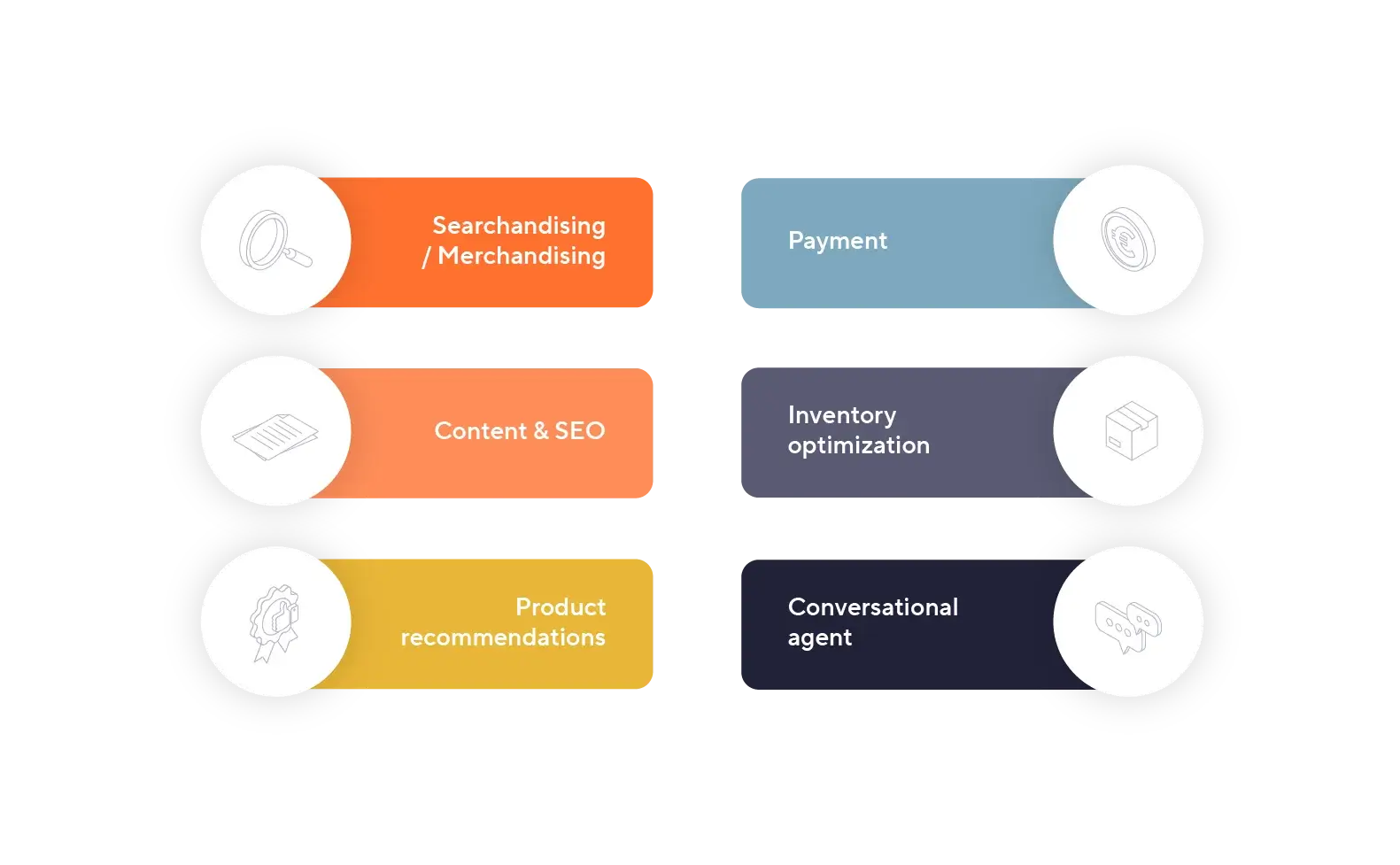AI enhancing e-commerce

According to a Salesforce study, revenue increases by 26% when a store is personalized and uses AI.
AI supports e-commerce businesses by saving time on essential, time-consuming tasks on an e-commerce site.

Five key use cases for AI in e-commerce
Searchandising and serchandising:
AI has been used for years to create more personalized shopping journeys, tailored to visitors’ needs (whether anonymous or returning customers), by making product searches more relevant and reducing the number of clicks needed to find the right product, ultimately boosting the add-to-cart rate.
In search engines:
- Generative AI generates synonyms within AI-driven search engines.
- Semantic AI interprets user intent in the search bar to deliver more relevant search results.
E-commerce and marketplace solution providers now integrate these AI tools, such as Adobe Commerce Cloud with Live Search, Intershop with Sparque, Mirakl with Target2Sell, and specialized solutions like Algolia, Sensefuel, EarlyBirds/Attraqt, and Nosto.
At SoBrico, Algolia has been used for 2-3 years to manage searchandising for a catalog of over 100,000 items. The goal was to reduce the clicks needed to find the right product. Today, 70% of site traffic comes through the search engine, which generates 50% of the revenue.
Content & SEO
For content creation and SEO optimization, AI can help develop site maps, write meta tags, create effective internal links, and generate content ideas for both product pages and informational pages about products and brands.
The ChatGPT AI Content Generator by Amasty, approved by Adobe Commerce Cloud, enables:
- Content creation for product and category pages
- Generation of structured data to optimize SEO
A word of caution for SEO: to improve search rankings, it’s crucial to stand out. Search engine algorithms prioritize originality and relevance based on the EEAT criteria: Expertise, Experience, Authority, and Trust. Avoid over-reliance on AI by:
- Adding personal stories and anecdotes
- Adopting the brand’s tone
- Tying content to recent events
- Citing verified sources
Product Recommendations
SoBrico recently implemented Algolia’s product recommendation tool, which considers both user search behavior and the freshness of the site’s data. To enable this, Algolia’s Events API was integrated to track all navigation, purchase, content, product, and customer events.
SoBrico uses this functionality to “push” products on the homepage, product pages, and add-to-cart page.
Conversational Agent
Often criticized for relying on basic decision trees, AI has significantly improved chatbots. The “Hello Casto” module is a case in point. With an intelligent chatbot, Castorama aimed to provide a new, innovative experience, offering personalized advice and product recommendations.
The goal was to address an online “pain point” by replicating the in-store shopping experience.
The chatbot features open-ended questions, requiring extensive data collection, contextualization, and conversational design.
It took six weeks to launch the first version, which involved integrating service AI tools, designing use cases based on user needs, and creating the digital experience and interface.
This service was tested with about 20 users and testers before launching in the power tools category. Castorama enriched the chatbot with its brand tone, internal expertise, and product guides while anticipating subversive use cases.
Technically, Castorama used Kingfisher Group’s Athena framework, leveraging three leading language models—Google’s Gemini, OpenAI’s ChatGPT, and Anthropic’s Claude—to ensure the most suitable model is used per case and to meet regulatory and editorial standards.
Castorama recognizes that customer adoption will take time. Although the site sees significant traffic (10-15 million visits), users are not yet accustomed to interacting with avatars. Most rely on traditional navigation and search bars.
Inventory Optimization
So far, these examples show how AI impacts the user experience. But AI also brings high-value operational benefits to e-commerce, especially in inventory management. Through machine learning algorithms and real-time data analysis, AI enables a proactive and dynamic approach, surpassing traditional methods (manual processes and statistical rules).
Leveraging AI, companies can now optimize stock levels based on sales data and third-party information (weather, seasonality, market trends), reducing excess stock and stock-out risks, which in turn lowers storage and holding costs.
AI also optimizes warehouse operations, improving storage and retrieval efficiency, reducing labor costs, and increasing productivity.
In conclusion
Generative AI is undeniably a powerful tool, enhancing efficiency and productivity. It produces analyses, gathers information, and generates content impressively. However, human expertise remains irreplaceable.
AI’s limitations are evident in its learning boundaries, potential “hallucinations,” and its struggles to interpret, select, and handle reliable sources.
Three takeaways for adopting AI in your business
- Facilitate change management to explain AI, its usage, and the evolution of roles for those using it.
- Ensure security, data hosting, and AI solution architecture, along with intellectual property rights.
- Avoid falling behind but don’t rush—consider objectives and the best approach to implement AI.

AI is a tool, not a magic solution
Keep the customer at the center of your strategy and people at the heart of this transformation.
AI usage must align with ethical standards
Maintaining control over your content, data, and customer journeys is essential.
Don’t fall behind
Mastering customer experiences is a major competitive advantage to set you apart from your competitors.
If this topic interests you, it’s part of a series of three articles we’ve written for you:
AI for an improved customer experience
AI serving the product experience
Do you need advice on integrating AI
into your customer service?
Do you have a project or ideas?


